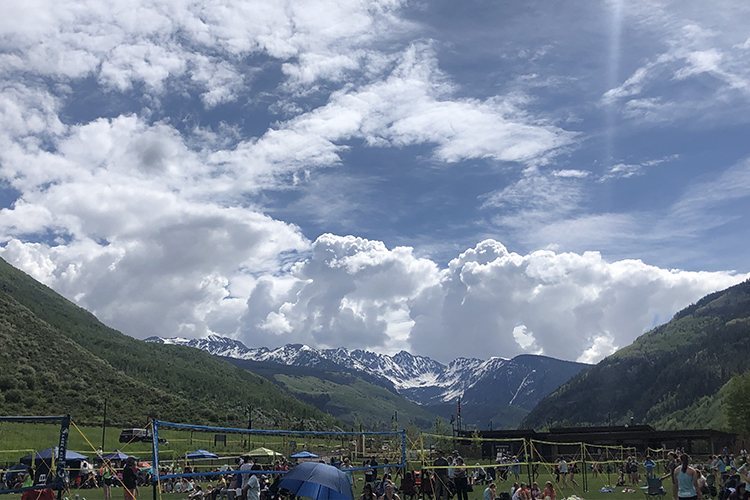
The 2019 King of the Mountain tournament in Vail, CO. photo by Madelyn Staples
Digging deeper into outdoor volleyball
The 2020 outdoor volleyball season is approaching. Outdoor volleyball includes playing on both sand and grass courts. Outdoor challenges the characteristics of a player by forcing them to adapt to the different specifics of outdoor such as the clothing, the weather, the lack of players, and most importantly, the ground. Outdoor is most commonly played two versus two, but can be played four versus four or six versus six.
Outdoor can be harder than indoor because it can challenge people’s physical and communication abilities more. There are also a lot more aspects to consider when playing. Though it sounds not as serious, clothing is actually a significant factor. The majority of indoor volleyball uniforms are basic long sleeve or short sleeve jerseys with spandex and knee pads. Outdoor uniforms, on the other hand, are usually tank tops with spandex and most players play barefoot. Players who compete on the collegiate and national level usually play in swimsuits, which makes it more difficult to combat the elements. There are no knee pads, no arm pads, and no extra protection against the ground.
The weather is also a huge factor to consider. Most players choose to wear enhanced sunglasses to block out the sun and working against the wind is not an easy thing to do. Depending how severe the wind is, it can completely change the way a game is played; serves, setting, passing angles, and hitting all get altered when the wind comes into play. Sun exposure is also a factor as most players play with minimal clothing the chance of getting a sunburn is extremely high. Players often take several timeouts to reapply sunscreen throughout matches and still get burned.
After all of these difficulties, having fewer players also presents a challenge. Indoor games are usually played six versus six and outdoor can be played like this as well, but it mostly played two versus two. This absence of players requires the two players to be more prepared and tests their athleticism. Ball control is a necessity when it comes to playing because the athletes don’t have the extra help when it comes to getting the ball over the net. Having only one other person to split the court forces outdoor volleyball players to improve their communication skills. “Outdoor really focuses on teamwork. It really helps bond two people because there is only one person you communicate with and you really have to be direct,” mentioned junior Zoe Henke.
The most challenging aspect to take into consideration however, is the ground. Sand can be extremely coarse and difficult to navigate. Sand cuts through skin very easily and getting scratches from playing on sand is almost guaranteed. Though playing on sand courts is difficult, it challenges and benefits players’ agility and their jumping vertical. 303 outdoor coach/Volleyball of the Rockies player Ian Byrne mentioned, “The benefits are outstanding, especially if you are playing sand volleyball. It is a great way to workout your vertical jump, speed, agility, conditioning, core and leg strength.” Sophomore Olivia Oss confirmed this, “When you’re playing outdoor you have less support in your ankles, but it definitely helps strengthen your vertical for indoor volleyball.” Grass also can present difficulties as there is no cover for the courts, so weather like rain can immediately change the game from being clean to severely messy with mud. Due to elements like mud, grass can also be extremely slick and cause the courts to become more dangerous.
Outdoor volleyball is not as widely acknowledged or recognized as indoor, however, several private clubs across Colorado offer the opportunity for people ages 11-19 to play outdoor. Programs such as: 303 Volleyball Academy, Believe, Momentum, Elevation, Dive, Front Range, NORCO, The Diff, Alpine Volleyball Academy, Relentless, Colorado Juniors (COJO), Rocky Mountain USA, Flatirons, Spikes, CVA, and JumpStart all offer the sport. There are also places like The Island that provide indoor sand courts without coaches, where players can practice or play in their free time. Adults ages 20 and over can also compete without the representation of a club. Most of the outdoor volleyball programs and players compete in tournaments such as the King of the Mountain in Vail or the one of the several Volleyball of the Rockies (VOTR) in Steamboat Springs. These popular tournaments host hundreds of volleyball players and amateurs who are all eager to show off their skills on the grass courts. Thousands upon thousands get together to play whenever and wherever, whether that be just a fun day at the beach or at an olympic match. Both indoor and outdoor volleyball present unique challenges of their own. Outdoor volleyball however, presents a fun and elevated physical challenge when compared to indoor. Outdoor brings joy to all those willing to give it a shot.